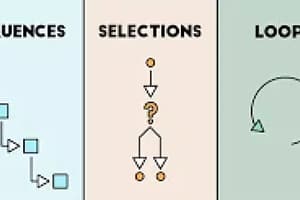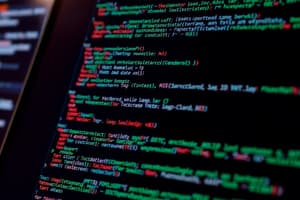Podcast
Questions and Answers
How many lab sessions must students attend weekly starting from week 3?
How many lab sessions must students attend weekly starting from week 3?
- No lab sessions
- 3 lab sessions
- 2 lab sessions
- 1 lab session (correct)
What is the total number of credit hours for the Structured Algorithm & Programming course?
What is the total number of credit hours for the Structured Algorithm & Programming course?
- 3 Units
- 4 Units
- 6 Units
- 5 Units (correct)
Who is the course coordinator for the Structured Algorithm & Programming course?
Who is the course coordinator for the Structured Algorithm & Programming course?
- Afnan Amirruddin (correct)
- Course Teaching Team
- Zuraini Hanim Bt Zaini
- Not specified
What is the primary focus of the Structured Algorithm & Programming course?
What is the primary focus of the Structured Algorithm & Programming course?
How many hours of lecture are conducted each week for this course?
How many hours of lecture are conducted each week for this course?
What are the two states in which data is represented in a computer?
What are the two states in which data is represented in a computer?
Which component is responsible for processing data in a computer?
Which component is responsible for processing data in a computer?
Which of the following best describes a computer program?
Which of the following best describes a computer program?
Which of the following is NOT listed as a chapter lesson outcome?
Which of the following is NOT listed as a chapter lesson outcome?
What percentage of the overall assessment is attributed to coursework?
What percentage of the overall assessment is attributed to coursework?
Which device is NOT typically used for wireless communication?
Which device is NOT typically used for wireless communication?
In the client-server model, what does the client do first?
In the client-server model, what does the client do first?
Which of the following is an example of cloud computing services?
Which of the following is an example of cloud computing services?
What is the primary function of a server in the client-server model?
What is the primary function of a server in the client-server model?
Which statement about Internet and networking is true?
Which statement about Internet and networking is true?
What is the value relationship between capital and small letters in the ASCII table?
What is the value relationship between capital and small letters in the ASCII table?
Which of the following is NOT a category of computers mentioned?
Which of the following is NOT a category of computers mentioned?
Which coding scheme is primarily used for text representation in computers?
Which coding scheme is primarily used for text representation in computers?
What characterizes an embedded computer?
What characterizes an embedded computer?
What type of computer is designed to provide services to other computers in a network?
What type of computer is designed to provide services to other computers in a network?
Which category includes devices like smartphones and digital cameras?
Which category includes devices like smartphones and digital cameras?
How many bits are there in 1 byte?
How many bits are there in 1 byte?
What best describes a mainframe computer?
What best describes a mainframe computer?
What is the primary function of the central processing unit (CPU)?
What is the primary function of the central processing unit (CPU)?
Which component is responsible for storing the operating system and system software?
Which component is responsible for storing the operating system and system software?
What does RAM primarily store during computer operation?
What does RAM primarily store during computer operation?
What notable statement did John F. Kennedy make about computers?
What notable statement did John F. Kennedy make about computers?
Which device is NOT considered a part of computer hardware?
Which device is NOT considered a part of computer hardware?
What is the role of the control unit within the CPU?
What is the role of the control unit within the CPU?
What type of device is typically used for user input?
What type of device is typically used for user input?
What does the term supercomputer refer to?
What does the term supercomputer refer to?
Study Notes
Course Overview
- Course Code: FBT0015/FCT0015/FCT0035 Structured Algorithm & Programming
- Credit Hours: 5 Units
- Lecture Format: 4 hours per week
- Lab Format: 2 hours per week (1 lab session)
- Course Coordinator: Afnan Amirruddin (Email: [email protected])
- Lecturer: Zuraini Hanim Bt Zaini (Email: [email protected])
Attendance and Lab Requirements
- Attendance: 2 lectures weekly within assigned groups
- Lab attendance: 1 compulsory session starting from week 3
Course Objectives
- Understand basic computing concepts
- Apply systematic problem-solving using computer logic
- Develop functioning computer programs using a programming language
Assessment Breakdown
- Final Examination: 50%
- Coursework: 50% (including Test 1, Test 2, lab works, lab test, quizzes)
- Lab Works: 15%
- Lab Test: 5%
- Quizzes: 10%
Chapter 1 Learning Outcomes
- Understand key concepts:
- Computer systems
- Hardware and software
- Networking
- Data analysis and security
- Ethics in computing
Computer Fundamentals
- Definition: Electronic devices that receive, process, store data, and output information based on instruction sets.
- Data Representation: Uses binary digits (0 and 1) known as bits, with 8 bits forming 1 byte.
Popular Coding Schemes
- ASCII (American Standard Code for Information Interchange)
- EBCDIC (Extended Binary Coded Decimal Interchange Code)
- Unicode
Categories of Computers
- Personal Computers: Includes laptops, desktops, and tablets; designed for individual use.
- Mobile Computers: Portable devices like smartphones, digital cameras, and game consoles.
- Embedded Computers: Special-purpose computers integrated into larger products.
- Servers: Provide services to other computers in a network; robust systems capable of handling numerous connections.
- Mainframes: Large, powerful computers for extensive processing tasks.
- Supercomputers: Capable of processing trillions of instructions per second, housed in large environments.
Computer Components
- Hardware Components:
- Input Devices: Mechanisms for data entry (e.g., keyboards, mice).
- Output Devices: Mechanisms for data output (e.g., monitors, printers).
- System Unit: Houses essential components for processing data.
- Memory:
- ROM: Stores firmware and operating systems.
- RAM: Stores application programs and current data.
- Network Devices: Facilitate communication over networks (e.g., routers, Bluetooth adapters).
Networking Concepts
- Client-Server Model:
- The client requests a webpage from a server, which processes the request and sends a response back.
- Internet: A vast network of interconnected networks as of 2022.
- Cloud Computing: Allows users to access resources and services over the Internet, including software, storage, and applications.
Key Takeaways on Computer Hardware
- Know how to describe and identify:
- Input Devices
- Output Devices
- Memory and Storage Devices
- Network Devices
- System Unit
Studying That Suits You
Use AI to generate personalized quizzes and flashcards to suit your learning preferences.
Related Documents
Description
This quiz covers the key concepts introduced in Chapter 1 of the Structured Algorithm & Programming course. It is designed for students enrolled in the semester starting September 2024. Prepare to test your understanding of the fundamental principles of computer programming.




